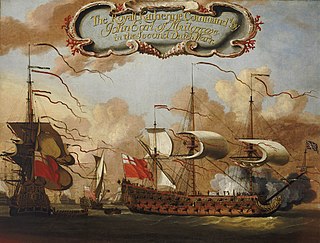Eight ships of the Royal Navy have been named HMS Royal Oak, after the Royal Oak in which Charles II hid himself during his flight from the country in the English Civil War:
Sixteen vessels and two shore establishments of the Royal Navy have been named HMS Phoenix, after the legendary phoenix bird.
Several vessels of the Royal Navy have been named HMS Nonsuch, presumably named after Nonsuch Palace:
Five ships of the Royal Navy have been named HMS Albemarle after George Monck, 1st Duke of Albemarle.
Five ships of the Royal Navy have been named HMS Ramillies after the Battle of Ramillies :

HMS Royal Katherine was an 84-gun full-rigged second-rate ship of the line of the Royal Navy, launched in 1664 at Woolwich Dockyard. Her launching was conducted by Charles II and attended by Samuel Pepys. Royal Katherine fought in both the Second and Third Anglo-Dutch Wars and afterwards, the War of the Grand Alliance before entering the dockyard at Portsmouth for rebuilding in 1702. In this rebuilding, she was upgraded to carry more guns, 90 in total, and served in the War of the Spanish Succession during which she was renamed Ramillies in honour of John Churchill's victory at the Battle of Ramillies. She was rebuilt again in 1742–3 before serving as the flagship of the ill-fated Admiral John Byng in the Seven Years' War. Ramillies was wrecked at Bolt Tail near Hope Cove on 15 February 1760.
Six ships of the Royal Navy have borne the name HMS Griffin, after the legendary creature, the Griffin:
Fourteen ships of the Royal Navy have borne the name Kingfisher, after the kingfisher bird:
Fourteen ships of the Royal Navy have been named HMS Roebuck after a small deer native to the British Isles:

Fourteen ships of the French Navy or the Galley Corps of the Ancien Régime or Empire have borne the name Couronne ("crown"):
Six ships of the Royal Navy have been named HMS Colchester, after the town of Colchester:

USS Crux (AK-115) was a Crater-class cargo ship, converted from a Liberty Ship, commissioned by the US Navy for service in World War II. She was first named after Peter Stuyvesant, a Dutch politician that served as the last Dutch director-general of the colony of New Netherland from 1647 until it was ceded provisionally to the English in 1664. She was renamed and commissioned after Crux, a constellation centered on four stars in the southern sky in a bright portion of the Milky Way. She was responsible for delivering troops, goods and equipment to locations in the war zone.
HMS Royal Oak was a 100-gun first rate ship of the line of the Royal Navy, launched in 1664 at Portsmouth Dockyard. Royal Oak was built by John Tippetts, Master-Shipwright at Portsmouth 1660-8, who later became Navy Commissioner and subsequently Surveyor of the Navy.
HMS Rupert was a 64-gun third rate ship of the line of the Royal Navy, launched at Harwich Dockyard on 26 January 1666 and broken up in 1769.
Thirteen ships of the Royal Navy have borne the name HMS Experiment:

Harwich Dockyard was a Royal Navy Dockyard at Harwich in Essex, active in the 17th and early 18th century. Owing to its position on the East Coast of England, the yard was of strategic importance during the Anglo-Dutch Wars; however, due to a lack of deep-water access and the difficulty of setting off from Harwich against an easterly wind, its usefulness was somewhat limited and its facilities remained small-scale compared to the other Royal Dockyards over the same period. Nonetheless, it remained actively involved in repairing and refitting the nation's warships, as well as building them: of the eighty ships built for the Royal Navy in Britain between 1660 and 1688, fourteen were built at Harwich Dockyard..
HMS Katherine has been the name of various ships of the British Royal Navy:
Sixteen ships of the Royal Navy have borne the name HMS Cygnet, the name given to a young swan:

The Leon Trionfante class were a class of at least fourteen 70-gun third-rate ships of the line built by the Venetian Arsenale from 1716 to 1785, in four different series with minor changes in the ships' length. In 1797, when Venice fell to the French, Napoleon captured several ships of the class, still unfinished in the Arsenal: he chose one of them, forced the shipbuilders to have it completed and added it to his fleet en route for Egypt. After Campoformio, the remaining vessels were destroyed by the French to avoid their capture by the Austrian Empire.




